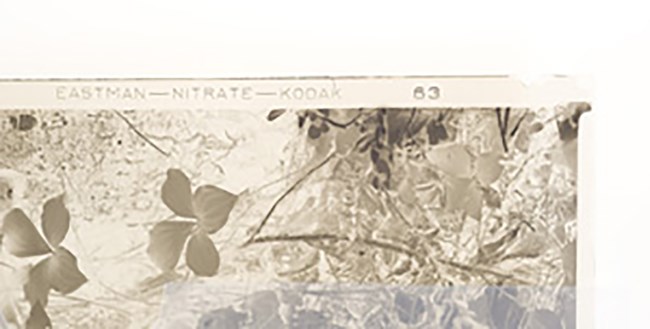Film Identification
It is important to be able to identify the types of film in your collection in oder to care for them appropriately. Cold storage is used to preserve two types of fim, cellulose nitrate and cellulose acetate, while blacka nd while pilyester film is stable and does not require cold storage. All color media does require cold storage regardless of its film base.
Because cold storage space is usally limited, it is important to target only those film collections requiring cold storage, and to identify nitrate film because it has additional fire code requirements.
There are three major types of plastic films used in photography--cellulose nitrate, cellulose acetat, and lastly, polyseter film. Cellulose nitrate was introduced in about 1890. It was used for a variety of formats, from motion picture film to various sheet films and even microfilm. Because it was highly flammable, the manufacturers began to replace these various formats with a safer versuib called safety film made from cellulose acetate. By the 1930s, cellulose acetate was commonly found in almost every format, such as 8-millimeter motion picture film, in the 1920s for x-ray films,and for sheet films in the 1930s. In 1960, polyester was introduced as another plastic film, although it stil competes with acetate, which is found on many formats today. Polyester film, however, is very stable and does not require cold storage, while acetate and nitrate deteriorate rapidly at room temperature and do require cold storage.
The History of Film Timeline
The history of film is complex. Even in the late 19th century, scientists and photographers were already experimenting and developing applications for this new flexible media. This timeline will serve as a valuable tool to assist you in understanding the nature of film-based materials in your collection. Using any available information on the date that an image was created, along with its film format, will help you in the film identification process.

Cellulose Acetate Visual Characteristics
- May be imprented or embossed with "safety" along the outer edge
- Look for a U-shaped notch code on sheet film from Kodak prior to 1940 (the first notch from the right when the film is held with the notches in the upper right corner)

Cellulose Acetate Deterioration Characteristics
- Detect a vinegar smell (acetic acid)
- Warping, buckling, or twisting (expescially along edges, not just slightly wavy)
- Channeling - the cellulose acetat base shrinks and distorts and air pockets form "channels" between film base and emulsion. May see crystals in the channels which are recrystallized placticizer
- Dimpling or orange peel texture from small air bubbles
- Film base becomes brittle (usually after severe channeling)

Cellulose Nitrate Deterioration Characteristics
- May be imprinted or embossed w/ "Nitrate" along the outer edge
- Look for a V-shaped notch code on sheet film from Kodak prior to 1940 (first notch from the right when the film is held with the notches in the upper right corner)
- Film base may be slightly yellow or tan even without deterioration

Cellulose Nitrate Deterioration Characteristics
- Amber, brown discoloration
- Silvering mirroring (acetate film can also have silver mirroring, but is more prevalent in nitrate film)
- Fading of image (most prevalent in this type of film, but can also occur in other film bases as well)
- Emulsion becomes tacky
- Noxious odor, acidic gases
- Film softens, viscous substance on surface, emulsion may liquify
- Film turns to brown powder
Polyester Film Visual Characteristics
-
May be imprinted with "Estar" if manufactured by Kodak
-
May be imprinted with "Cronar" if manufactured by DuPont
-
Some polyester can even be imprinted with "Safety" and confused with cellulose acetate
-
No warping, flat
Polyester Film Deterioration Characteristics
-
Polyester film has much greater chemical stability than cellulosic films, and it has virtually no visual deterioration characteristics inherent to the film base itself
-
However, black-and-white polyester film may undergo characteristic silver image deterioration (discoloration, silvering, fading) caused by poor processing (resideual chemicals)
-
Color polyester filim will fade at room temperatures and should be kept in cold storage due to the instability of the color dye image
This tool can be used to help you identify a piece of film as polyester or cellulosic, but it cannot be used to differentiate between the cellulose acetate and cellulose nitrate films. This identification is important because all cellulosic film requires cold storage, and most polyester films are stable in a normal archival environment. Here's a brief demonstration on the use of this tool.
This is a piece of polyester film, and as most films, the center of the film is very dark, so it's hard to get a good read on the film through the polarizing lens. however, if you take a part of the film that is light, like along the edges generally, put it between the viewer, hold the viewer up to the light and look through it, and if it's a polyester, you'll see what are called interference colors, or the reds and green colors. If you take a piece of cellulose acetate film, do the same thing, find a spot that's light, put it between the viewer, the two polarized films, hold it up to a light source, it will be dark. It will be dark black or blue and there will be no interference colors. This identification technique comes in very handy if the film is in relatively good condition and also if it's not edge marked and you can't readily tell if it says nitrate or safety.
Resources
When considering your cold storage needs, it is important to distinguish between polyester film supports and cellulosic supports (cellulose acetate and cellulose nitrate) since B&W polyester film does not need cold storage. This can be accomplished in a non-destructive manner by performing the Polarization Test with the use of a simple tool or “polarized film viewer.”
Last updated: December 18, 2019
